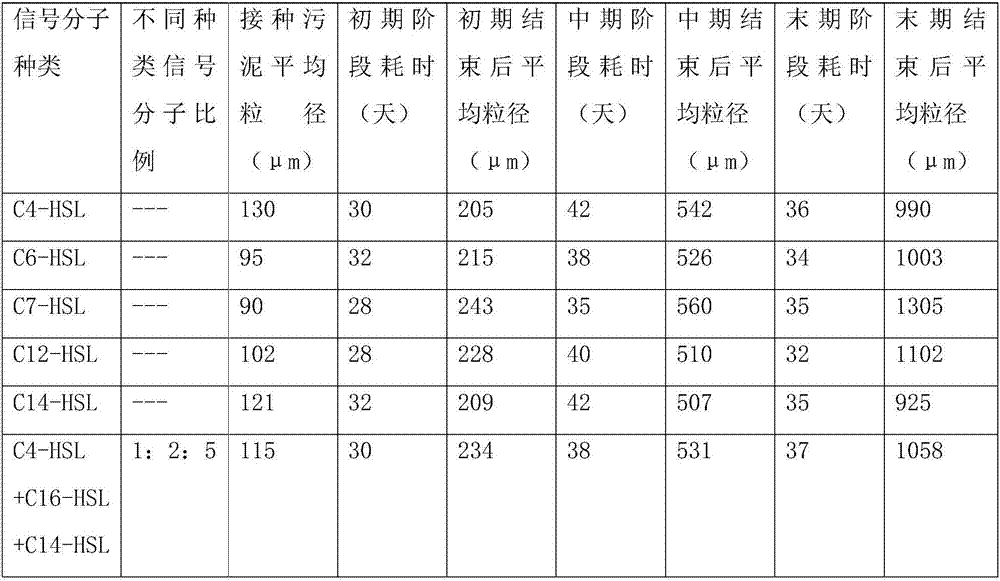Method for improving anaerobic sludge granulation efficiency
An anaerobic sludge and granulation technology, applied in anaerobic digestion treatment, chemical instruments and methods, biological treatment adjustment methods, etc. The effect of improving efficiency
- Summary
- Abstract
- Description
- Claims
- Application Information
AI Technical Summary
Problems solved by technology
Method used
Image
Examples
Embodiment 1
[0038] A method for improving the efficiency of anaerobic sludge granulation, the specific steps are as follows:
[0039] (1) Inoculation sludge: Anaerobic flocculent sludge was taken from a fermentation pharmaceutical factory in Anhui as inoculation sludge. The types and contents of AHLs in the inoculation flocculent sludge were qualitatively and quantitatively detected, and C8-HSL was confirmed as the main AHLs. C8-HSL was selected as the exogenously added AHL; the initial inoculum concentration was 30g / L, and the average particle size of the sludge was 92μm; EGSB reactor: made of PVC (polyvinyl chloride) material, and its effective volume was 1.87L;
[0040] (2) The sewage is synthetic organic wastewater in the laboratory, and its components are: glucose 1000-3000mg / L, ammonia nitrogen 25-75mg / L, sodium dihydrogen phosphate dihydrate 25.2-75.5mg / L, sodium bicarbonate 1000-3000mg / L; trace elements are also added to the organic wastewater, and the concentrations of the trace ...
Embodiment 2
[0049] The flocculent sludge of an alcohol factory was granulated by using the same specification EGSB reactor without adding exogenous signal molecules and adding exogenous signal molecules, and the granulation rate was compared.
[0050] Qualitative and quantitative detection of the types and contents of AHLs in the inoculated flocculent sludge confirmed that C10-HSL was the main AHLs, so C10-HSL was selected as the exogenously added AHL.
[0051] The EGSB reactor without exogenous signal molecules was used as the control group, denoted as R0, and the EGSB reactor added with exogenous signal molecules was used as the experimental group, denoted as R1. The initial inoculum concentration is 30g / L, and the average particle size of the sludge is 122μm; EGSB reactor: made of PVC (polyvinyl chloride) material, and its effective volume is 1.87L;
[0052] The sewage is synthesized organic wastewater in the laboratory, and its components are: glucose 1000-3000mg / L, ammonia nitrogen 2...
Embodiment 3
[0064] The flocculent sludge of a fermentation pharmaceutical factory was granulated by using EGSB reactors of the same specification without adding exogenous signal molecules and adding exogenous signal molecules, and the influent of the anaerobic process section of the plant was used as the influent of the reactor. its granulation rate.
[0065] Qualitative and quantitative detection of the types and contents of AHLs in the inoculated flocculent sludge confirmed that C8-HSL and C10-HSL were the main AHLs, and the concentration ratio of the two was 1:2, so C8-HSL and C10-HSL were selected as exogenous additions For AHLs, the concentration ratio is 1:2.
[0066] The actual basic indicators of organic wastewater are: COD 5998±623mg / L, ammonia nitrogen 368±54mg / L, total nitrogen 380±48mg / L, total phosphorus 5.1±1.8mg / L, pH range 7.2-7.8, Cl - The concentration is about 3000mg / L.
[0067] The EGSB reactor without exogenous signal molecules was used as the control group, denoted...
PUM
| Property | Measurement | Unit |
|---|---|---|
| The average particle size | aaaaa | aaaaa |
| The average particle size | aaaaa | aaaaa |
| The average particle size | aaaaa | aaaaa |
Abstract
Description
Claims
Application Information
 Login to View More
Login to View More - R&D
- Intellectual Property
- Life Sciences
- Materials
- Tech Scout
- Unparalleled Data Quality
- Higher Quality Content
- 60% Fewer Hallucinations
Browse by: Latest US Patents, China's latest patents, Technical Efficacy Thesaurus, Application Domain, Technology Topic, Popular Technical Reports.
© 2025 PatSnap. All rights reserved.Legal|Privacy policy|Modern Slavery Act Transparency Statement|Sitemap|About US| Contact US: help@patsnap.com


